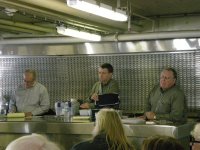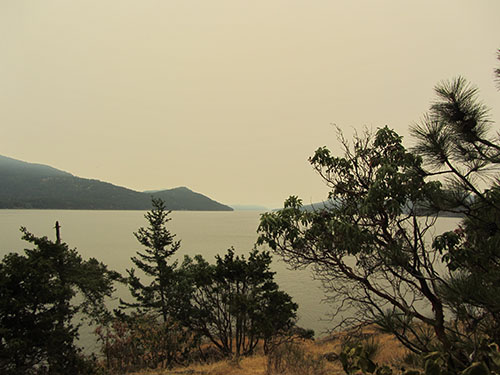
Ferry meeting
At the interisland ferry meeting on Jan. 15, residents of San Juan, Orcas, Shaw and Lopez Island (pictured below right) heard Washington State Ferries (WSF) officials present their draft long-range plan.
The WSF draft long-range plan, published Dec. 19, is in fulfillment of a directive from 2007 legislation.
Ferries Division head David Moseley, (pictured above right, along with Ray Deardorff, WSF staff, and Ed Sutton, San Juans’ Ferry Advisory Committee chair, left to right) said unequivocably stated that the key problem facing WSF and its riders is long-range funding: “The ferries are not financially sustainable.”
Deardorff introduced the 99-page Executive Summary of the draft plan, saying that WSF was charged with three key goals.
- to maximize existing system capacity
- to plan adaptive management and pricing strategies
- to deliver the highest service at the lowest cost
Deardoff agreed that the key challenge facing WSF was “the lack of capital funding for investment.” He pointed out that the ferries have “an aging asset base,” with the average age of vessels being 34 years, and that there is a long lead time for vessel construction.
The plan presented two options, (see Dec. 22 Bullwings post), both resulting in a shortfall.
Plan A would require $3.5 billion additional funding. Plan B, a leaner option with fewer boats in service, would still come up short $1.4 billion. Moseley stated that the shortfall would need to come from other sources.
Financing options are being identified by the State Transportation Commission; their conclusions to the Legislature are expected mid-February.
Moseley said, “In this session, our hope is that the legislature will pass legislation” to address the funding problems that have plagued the ferries system since state Initiative 695 was passed in 2000, revoking the Motor Vehicle Excise Tax.
Both options involve a reservation system for vehicles, tailored to the needs of each route and users of the route, plan to keep terminal impacts to the community at a minimum, add and bolster transit solutions for walk-ons, increase passenger fares at half the rate of vehicle fares to encourage walk-ons, and keep increases of fares to 2.5% per year, with the possibility of fuel surcharges at times.
Plan A would build 10 new vessels by 2030, with the Sealth becoming the interisland boat in the spring, summer and fall, and an Illahee-sized vessel to operate in the San Juans in the winter.

another ferry meeting
Plan B will retire without replacing vessels, resulting in 3 boats instead of 4 in the fall, winter and spring, and four boats instead of 5 in the summer. This plan cuts the Sidney, B.C. destination from the San Juans’ route. Other routes in the system will also see cuts under this plan, resulting in 17 vessels and no standby boat in case of vessel breakdown.
The San Juan County Council rejected Plan B, which cuts ferry service from several runs throughout Puget Sound, and said that Plan A provides minimal service. In its letter to Moseley, the Council said:
By eliminating the Anacortes/San Juans/Sidney vessel, over 80 % of the domestic service capacity on that vessel is eliminated for seven months of the year, which is a 20% reduction in daily service capacity during this period.
Plan B does not meet current or future service demands.
There is insufficient information and time on both plans to allow the legislative bodies and communities to participate in a meaningful review.
Lack of a financing component, as required by ESHB 2358, makes qualitative decisions impossible.
Plan B removes one vessel from a totally ferry-dependent community.
….
Balancing the state budget for the 2009-11 biennium should not be the justification for a long-term state service mistake.
For the complete County response to the WSF draft, go to the Jan. 14 Bullwings post, “Letter from County’s Council and Ferry Advisory Committee reject Plan B.”
Many on the four-hour route expressed the need for the continued run of the Sidney B.C. ferry route from the San Juans, and the need for the interisland ferry. San Juan resident Allison Johnston-Laurie said that many people who regularly use the interisland boat were not at the hearing, but at their jobs.
County Council member Lovel Pratt commented, as an individual, “The plan doesn’t identify an adequate funding source.” She also noted that the legislature’s restriction that ferries be constructed only by state shipbuilders restricts the state from using federal stimulus funds.
Questions about reservations and options for sustainable funding for ferries were also asked.
During the past week, WSF conducted a series of eight meetings as public hearings of ferry-served communities, and will present their findings to the legislature.
A public rally in Olympia is scheduled for Feb. 17.
For further information on ferries legislation, go to www.leg.wa.gov/legislature, and type in “ferries.”
Comments are still sought for input to the draft plan, by email to wsfplanning@wsdot.wa.gov, or by mail to WSF, Attention Joy Goldenberg
2901 3rd Avenue, Suite 500
Seattle WA 98121-104






